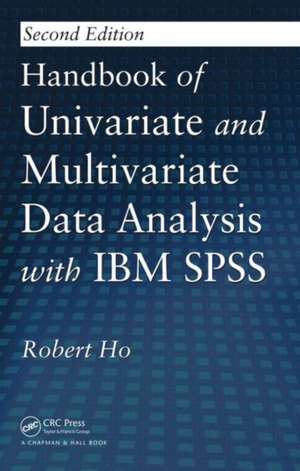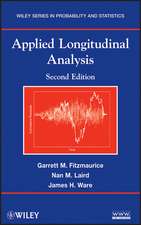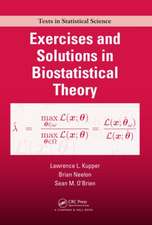Handbook of Univariate and Multivariate Data Analysis with IBM SPSS
Autor Robert Hoen Limba Engleză Hardback – 25 oct 2013
New to the Second Edition
- Three new chapters on multiple discriminant analysis, logistic regression, and canonical correlation
- New section on how to deal with missing data
- Coverage of tests of assumptions, such as linearity, outliers, normality, homogeneity of variance-covariance matrices, and multicollinearity
- Discussions of the calculation of Type I error and the procedure for testing statistical significance between two correlation coefficients obtained from two samples
- Expanded coverage of factor analysis, path analysis (test of the mediation hypothesis), and structural equation modeling
| Toate formatele și edițiile | Preț | Express |
|---|---|---|
| Paperback (1) | 299.52 lei 6-8 săpt. | |
| CRC Press – 21 ian 2023 | 299.52 lei 6-8 săpt. | |
| Hardback (1) | 688.96 lei 6-8 săpt. | |
| CRC Press – 25 oct 2013 | 688.96 lei 6-8 săpt. |
Preț: 688.96 lei
Preț vechi: 810.54 lei
-15% Nou
Puncte Express: 1033
Preț estimativ în valută:
131.83€ • 138.01$ • 109.08£
131.83€ • 138.01$ • 109.08£
Carte tipărită la comandă
Livrare economică 05-19 aprilie
Preluare comenzi: 021 569.72.76
Specificații
ISBN-13: 9781439890219
ISBN-10: 1439890218
Pagini: 586
Ilustrații: 850 black & white illustrations
Dimensiuni: 156 x 234 x 33 mm
Greutate: 0.98 kg
Ediția:Revizuită
Editura: CRC Press
Colecția CRC Press
ISBN-10: 1439890218
Pagini: 586
Ilustrații: 850 black & white illustrations
Dimensiuni: 156 x 234 x 33 mm
Greutate: 0.98 kg
Ediția:Revizuită
Editura: CRC Press
Colecția CRC Press
Public țintă
Professional Practice & DevelopmentCuprins
Inferential Statistics and Test Selection. Introduction to SPSS. Multiple Response. t Test for Independent Groups. Paired-Samples t Test. One-Way Analysis of Variance, with Post Hoc Comparisons. Factorial Analysis of Variance. General Linear Model (GLM) Multivariate Analysis. General Linear Model: Repeated Measures Analysis. Correlation. Linear Regression. Factor Analysis. Reliability. Multiple Regression. Multiple Discriminant Analysis. Logistic Regression. Canonical Correlation Analysis. Structural Equation Modeling. Nonparametric Tests. Appendix. Bibliography. Index.
Recenzii
"Using IBM SPSS as the main statistical tool, Ho tries to alleviate the frustration of social sciences students when confronted with data analysis and is more than successful. In addition, this book can be very useful for applied researchers in other disciplines who intend to deal with data. Very efficiently, the author explains how to select and execute appropriate tests, together with interpretation of the relevant SPSS output. … I strongly recommend [the book] to both students and researchers who already deal or will deal with data."
—Journal of Applied Statistics, 2015
Praise for the First Edition:
"The click-by-click instructions would clearly be useful for beginners to SPSS … The examples and methods all have a strong social science flavor, which is consistent with the aims of the book. … This book would therefore seem to be most appropriate for statisticians or practitioners in the social sciences … the book can [also] help more experienced SPSS users who want to learn to write syntax files. …"
—Biometrics, December 2006
"… main strengths are the choice of easy-to-use software to apply statistical methods and the clarity of explanations. Learning to analyse data with SPSS with this handbook is very easy even for those who are rusty … . I found no typological errors … author’s aims have been achieved. This is the best book I have found for demonstrating statistical methods with SPSS. I recommend it highly for all…"
—Venkata Putcha, Kings College, London, UK
"The main strengths of the book are: (a) its hands-on approach, (b) the choice of a user-friendly software to teach how to apply statistical methods, and (c) the clarity with which the statistical methods and the context of their applicability are explained. Learning to analyze data with SPSS with this handbook is very easy even for those rusty in their introductory statistical background. The reader that completes the book is ready to use the SPSS manuals available elsewhere. The index is very useful. …The authors do indeed provide clear guidelines to both the execution of the specific statistical tests with SPSS and the research designs for which they are relevant."
—Juana Sanchez, University of California, Los Angeles, Journal of Statistical Software, Vol. 16, July 2006
"This hardback covers most statistical methods provided by SPSS Base software in an easily understood manner, due in part to its liberal use of SPSS output and screenshots. … The inclusion of SPSS syntax is a strong selling point, as well as the focus on interpretation of SPSS output. It is an excellent choice for graduate students and researchers outside the statistics community who use SPSS …"
—J. Wade Davis, University of Missouri, The American Statistician, August 2008
—Journal of Applied Statistics, 2015
Praise for the First Edition:
"The click-by-click instructions would clearly be useful for beginners to SPSS … The examples and methods all have a strong social science flavor, which is consistent with the aims of the book. … This book would therefore seem to be most appropriate for statisticians or practitioners in the social sciences … the book can [also] help more experienced SPSS users who want to learn to write syntax files. …"
—Biometrics, December 2006
"… main strengths are the choice of easy-to-use software to apply statistical methods and the clarity of explanations. Learning to analyse data with SPSS with this handbook is very easy even for those who are rusty … . I found no typological errors … author’s aims have been achieved. This is the best book I have found for demonstrating statistical methods with SPSS. I recommend it highly for all…"
—Venkata Putcha, Kings College, London, UK
"The main strengths of the book are: (a) its hands-on approach, (b) the choice of a user-friendly software to teach how to apply statistical methods, and (c) the clarity with which the statistical methods and the context of their applicability are explained. Learning to analyze data with SPSS with this handbook is very easy even for those rusty in their introductory statistical background. The reader that completes the book is ready to use the SPSS manuals available elsewhere. The index is very useful. …The authors do indeed provide clear guidelines to both the execution of the specific statistical tests with SPSS and the research designs for which they are relevant."
—Juana Sanchez, University of California, Los Angeles, Journal of Statistical Software, Vol. 16, July 2006
"This hardback covers most statistical methods provided by SPSS Base software in an easily understood manner, due in part to its liberal use of SPSS output and screenshots. … The inclusion of SPSS syntax is a strong selling point, as well as the focus on interpretation of SPSS output. It is an excellent choice for graduate students and researchers outside the statistics community who use SPSS …"
—J. Wade Davis, University of Missouri, The American Statistician, August 2008
Descriere
This accessible handbook explains how to apply statistical tests to experimental findings, identify the assumptions underlying the tests, and interpret the findings. Updated with the SPSS statistical package for Windows, this second edition now covers more topics, including tests of assumptions and how to deal with missing data. It also offers three new chapters on multiple discriminant analysis, logistic regression, and canonical correlation and expands coverage of factor analysis, path analysis, and structural equation modeling.









